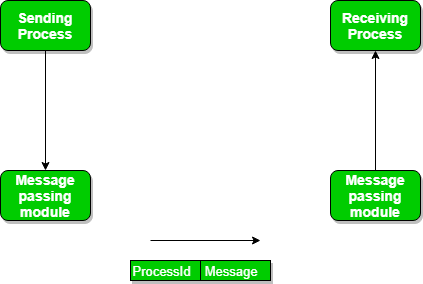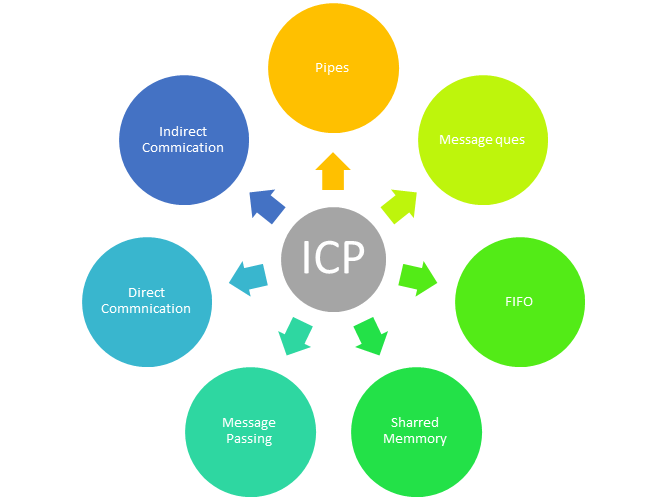A process can be of two types:
- Independent process.
- Co-operating process.
An independent process is not affected by the execution of other processes while a co-operating process can be affected by other executing processes. Though one can think that those processes, which are running independently, will execute very efficiently, in reality, there are many situations when co-operative nature can be utilized for increasing computational speed, convenience, and modularity. Inter-process communication (IPC) is a mechanism that allows processes to communicate with each other and synchronize their actions. The communication between these processes can be seen as a method of co-operation between them. Processes can communicate with each other through both:
- Shared Memory
- Message passing
Figure 1 below shows a basic structure of communication between processes via the shared memory method and via the message passing method.
An operating system can implement both methods of communication. First, we will discuss the shared memory methods of communication and then message passing. Communication between processes using shared memory requires processes to share some variable, and it completely depends on how the programmer will implement it. One way of communication using shared memory can be imagined like this: Suppose process1 and process2 are executing simultaneously, and they share some resources or use some information from another process. Process1 generates information about certain computations or resources being used and keeps it as a record in shared memory. When process2 needs to use the shared information, it will check in the record stored in shared memory and take note of the information generated by process1 and act accordingly. Processes can use shared memory for extracting information as a record from another process as well as for delivering any specific information to other processes.
Let’s discuss an example of communication between processes using the shared memory method.

i) Shared Memory Method
Ex: Producer-Consumer problem
There are two processes: Producer and Consumer. The producer produces some items and the Consumer consumes that item. The two processes share a common space or memory location known as a buffer where the item produced by the Producer is stored and from which the Consumer consumes the item if needed. There are two versions of this problem: the first one is known as the unbounded buffer problem in which the Producer can keep on producing items and there is no limit on the size of the buffer, the second one is known as the bounded buffer problem in which the Producer can produce up to a certain number of items before it starts waiting for Consumer to consume it. We will discuss the bounded buffer problem. First, the Producer and the Consumer will share some common memory, then the producer will start producing items. If the total produced item is equal to the size of the buffer, the producer will wait to get it consumed by the Consumer. Similarly, the consumer will first check for the availability of the item. If no item is available, the Consumer will wait for the Producer to produce it. If there are items available, Consumer will consume them. The pseudo-code to demonstrate is provided below:
Shared Data between the two Processes
ii) Messaging Passing Method
Now, We will start our discussion of the communication between processes via message passing. In this method, processes communicate with each other without using any kind of shared memory. If two processes p1 and p2 want to communicate with each other, they proceed as follows:
- Establish a communication link (if a link already exists, no need to establish it again.)
Start exchanging messages using basic primitives.
We need at least two primitives:
– send(message, destination) or send(message)
– receive(message, host) or receive(message)

The message size can be of fixed size or of variable size. If it is of fixed size, it is easy for an OS designer but complicated for a programmer and if it is of variable size then it is easy for a programmer but complicated for the OS designer. A standard message can have two parts: header and body.
The header part is used for storing message type, destination id, source id, message length, and control information. The control information contains information like what to do if runs out of buffer space, sequence number, priority. Generally, message is sent using FIFO style.
Approaches for Inter-Process Communication
Here, are few important methods for interprocess communication:
Pipes
Pipe is widely used for communication between two related processes. This is a half-duplex method, so the first process communicates with the second process. However, in order to achieve a full-duplex, another pipe is needed.
Message Passing:
It is a mechanism for a process to communicate and synchronize. Using message passing, the process communicates with each other without resorting to shared variables.
IPC mechanism provides two operations:
- Send (message)- message size fixed or variable
- Received (message)
Message Queues:
A message queue is a linked list of messages stored within the kernel. It is identified by a message queue identifier. This method offers communication between single or multiple processes with full-duplex capacity.
Direct Communication:
In this type of inter-process communication process, should name each other explicitly. In this method, a link is established between one pair of communicating processes, and between each pair, only one link exists.
Indirect Communication:
Indirect communication establishes like only when processes share a common mailbox each pair of processes sharing several communication links. A link can communicate with many processes. The link may be bi-directional or unidirectional.
Shared Memory:
Shared memory is a memory shared between two or more processes that are established using shared memory between all the processes. This type of memory requires to protected from each other by synchronizing access across all the processes.
FIFO:
Communication between two unrelated processes. It is a full-duplex method, which means that the first process can communicate with the second process, and the opposite can also happen.
Why IPC?
Here, are the reasons for using the interprocess communication protocol for information sharing:
- It helps to speedup modularity
- Computational
- Privilege separation
- Convenience
- Helps operating system to communicate with each other and synchronize their actions.
What is Like FIFOS and Unlike FIFOS
| Like FIFOS | Unlike FIFOS |
| It follows FIFO method | Method to pull specific urgent messages before they reach the front |
| FIFO exists independently of both sending and receiving processes. | Always ready, so don't need to open or close. |
| Allows data transfer among unrelated processes. | Not have any synchronization problems between open & close. |







No comments:
Post a Comment